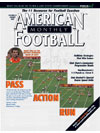AMERICAN FOOTBALL MONTHLY THE #1 RESOURCE FOR FOOTBALL COACHES
Article CategoriesAFM Magazine
|
Motion OffenseKeeping defenses off balance with motionby: Jerry Mack, Jr Wide Receivers Coach, Jackson State University © More from this issue It is an honor to write this article on behalf of Rick Comegy and the Jackson State offensive staff. We’ve been fortunate to be blessed with an array of talented athletes who have the ability to play multiple positions. Offensive coaches are always trying to find the edge on defenses. Using motion, shifting, and audibles at the line of scrimmage are just a few ways we try to create mismatches for every play. Defenses are doing an excellent job of recognizing different personnel groups and making simple adjustments to all the offensive games. We believe in a spread option attack along with a fast tempo offensive pace. The option allows us to threaten different areas of the field and make defenses play assignment football. We feel like we can keep defenses off balance with our spread option along with our full-field read passin....The full article can only be seen by subscribers. Subscribe today!
|
|
|||||||
| HOME |
MAGAZINE |
SUBSCRIBE | ONLINE COLUMNISTS | COACHING VIDEOS |
Copyright 2025, AmericanFootballMonthly.com
All Rights Reserved





